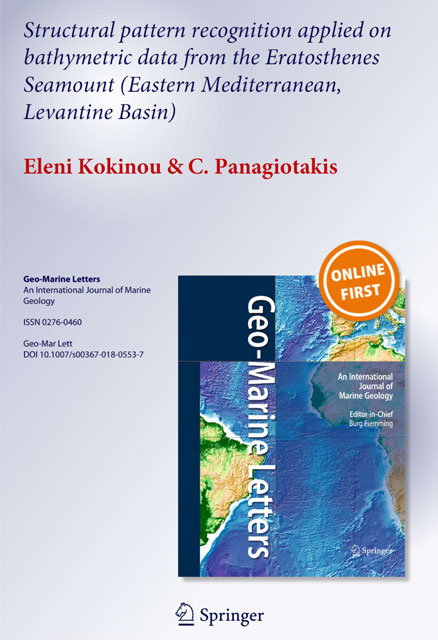Νέα δημοσίευση των Ε. Κοκίνου και Κ. Παναγιωτάκη, στο πλαίσιο του έργου sea4all. Κάντε λήψη του έργου από το σύνδεσμο shareit https://rdcu.be/bbMAi
Περίληψη
 The scope of the present work is to apply tested techniques of pattern recognition on bathymetric data from the Eratosthenes Seamount to (a) detect topographic highs and linear-curvilinear lineaments present on the seabed, (b) evaluate the morphostucture of the seamount and its relation with the degree of deformation the region has suffered, and (c) to check if shallow salt movements are associated with specific patterns on bathymetric data. Our scope is implemented by applying a two-step procedure on bathymetric data. Initially, the topographic highs in the study area are detected and their geomorphologic attributes (orientation, average slope, eccentricity, and shape complexity) associated with the degree of seabed deformation are computed. Then, quantitative attributes (slope, aspect, and their derivatives) are combined to automatically detect seabed morphologic structures (lineaments, highs, or depressions), which are potentially related to the presence of geological faults or triggered by other subsurface processes. Based on the analysis in this work, two major segments (the northern and the southern) are identified on the Eratosthenes Seamount and related to E–W trending oblique faults. These two segments are highly deformed according to the quantitative estimation of the geomorphologic attributes. Furthermore, ENE–WSW to NE–SW and WNW–ESE to NW–SE lineaments are identified and limit this prominent topographic high. Smaller topographic highs accompanied by topographic depressions, north and southwest of the Eratosthenes Seamount are also detected, showing medium to strong deformation and reflecting a similar geodynamic activity in this area. As a corollary, a comparison of the bathymetric patterns shows that the present seabed morphology north of the Eratosthenes Seamount relates to shallow salt movements, which create a chaotic pattern. This pattern is expressed by short and curved normal faults, shear zones, possible small-scale reverse faults, massive extrusion of salt bodies (possibly allochthonous), and Pliocene–Quaternary minibasins or peripheral sinks.
The scope of the present work is to apply tested techniques of pattern recognition on bathymetric data from the Eratosthenes Seamount to (a) detect topographic highs and linear-curvilinear lineaments present on the seabed, (b) evaluate the morphostucture of the seamount and its relation with the degree of deformation the region has suffered, and (c) to check if shallow salt movements are associated with specific patterns on bathymetric data. Our scope is implemented by applying a two-step procedure on bathymetric data. Initially, the topographic highs in the study area are detected and their geomorphologic attributes (orientation, average slope, eccentricity, and shape complexity) associated with the degree of seabed deformation are computed. Then, quantitative attributes (slope, aspect, and their derivatives) are combined to automatically detect seabed morphologic structures (lineaments, highs, or depressions), which are potentially related to the presence of geological faults or triggered by other subsurface processes. Based on the analysis in this work, two major segments (the northern and the southern) are identified on the Eratosthenes Seamount and related to E–W trending oblique faults. These two segments are highly deformed according to the quantitative estimation of the geomorphologic attributes. Furthermore, ENE–WSW to NE–SW and WNW–ESE to NW–SE lineaments are identified and limit this prominent topographic high. Smaller topographic highs accompanied by topographic depressions, north and southwest of the Eratosthenes Seamount are also detected, showing medium to strong deformation and reflecting a similar geodynamic activity in this area. As a corollary, a comparison of the bathymetric patterns shows that the present seabed morphology north of the Eratosthenes Seamount relates to shallow salt movements, which create a chaotic pattern. This pattern is expressed by short and curved normal faults, shear zones, possible small-scale reverse faults, massive extrusion of salt bodies (possibly allochthonous), and Pliocene–Quaternary minibasins or peripheral sinks.
